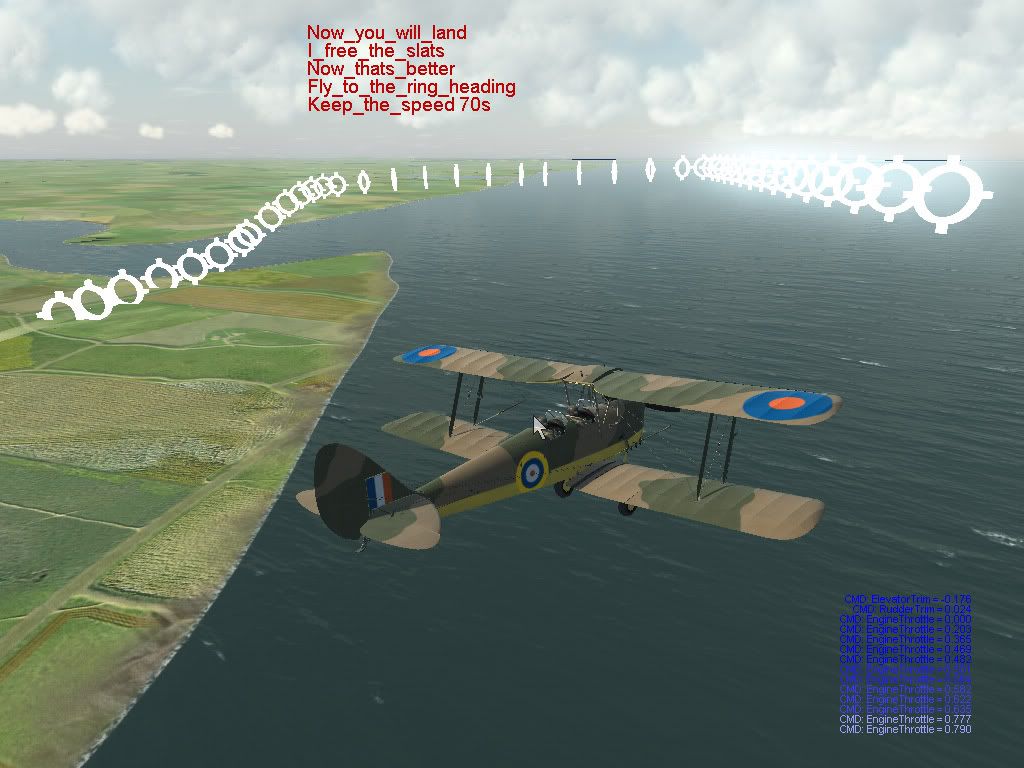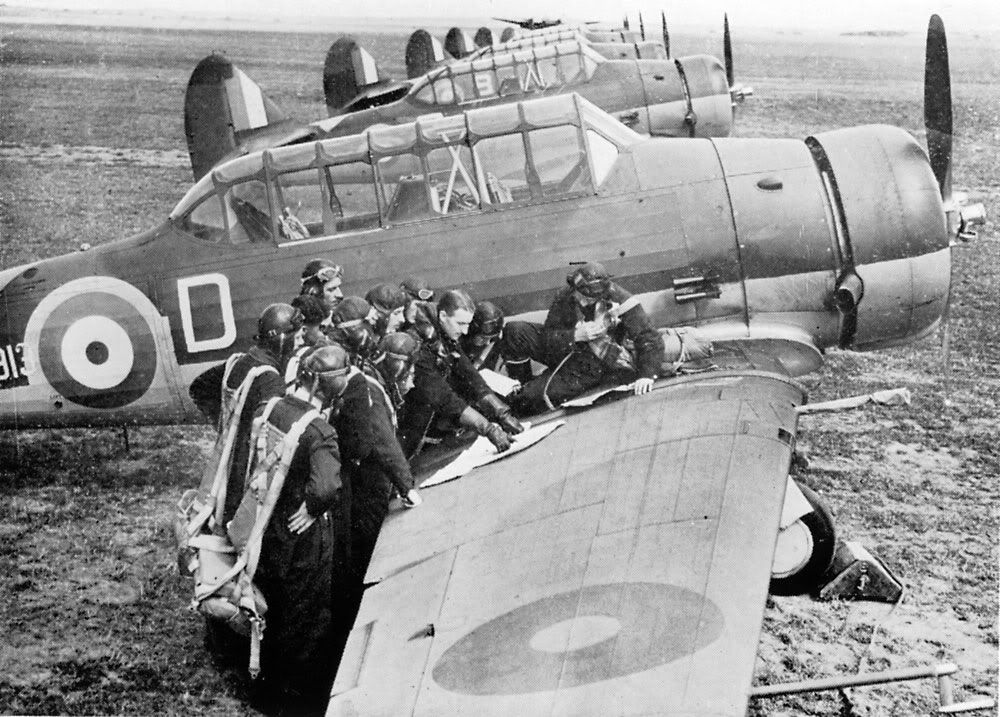Part 53.
November, 1940
A TALK ON ELEMENTARY FLYING TRAINING
BY A FLIGHT LIEUTENANT INSTRUCTOR
I'VE been doing elementary flying instruction for a couple of years now, and during that time many lads have passed through my hands and have become pilots.
At the school where I am an instructor we use light training types of aircraft. The particular type I instruct on has certain special qualities. In the first place it is easy to fly somehow, in the second place it is difficult to fly really well, and lastly, but perhaps most important of all, you have to fly it very badly and foolishly if you are going to crash it and possibly hurt yourself.
I would like to say just a word about this term "Elementary Instruction". A surprisingly large number of our pupils have never been in the air and in nine cases out of ten the pupil has never before handled the controls of an aeroplane. But at the end of his elementary training the pupil can, by himself, land the aeroplane consistently well, find his way from one aerodrome to another maybe fifty or more miles away, perform all the usual aerobatics, fly under the hood by the sole use of his instruments, and make a safe landing almost anywhere in the event of an engine failure. When he leaves us he goes on to the Service Flying Training School, where he carries out more advanced training.
I think the best way of giving you a picture of elementary training from the instructor's point of view is for me to try and describe the sequence of instruction from the day a new pupil arrives until the day he leaves.
When a batch of new pupils arrive at the school they are divided into two squads so that while one squad is flying, the other squad is attending lectures. Each instructor is given his quota: it may be any number between two and seven. Next morning all the pupils are to be found waiting outside their changing room looking, not unnaturally, rather uncomfortable at first in their new flying kit. I remember on one hot summer afternoon, I found a new pupil clad in a Sidcot suit with teddy-bear lining, lambskin flying-boots, two pairs of gloves and a thick woollen scarf wound several times round his neck! I think he must have been wearing every single item of kit with which he had been issued. Actually, of course, a light overall to keep one's shirt and trousers clean is all that is necessary in that sort of weather.
Then, having found my pupil, I have a chat with him so that I can size him up and find out whether he has had any flying experience. The pupil then gets into the rear cockpit and I show him how to secure his safety harness and connect up his telephone so that we can talk to each other when we ate in the air. After explaining to him the various controls and instruments and telling him to leave everything alone for the time being, I get into the front cockpit, start the engine, taxi out and we take off.
The first quarter of an hour is taken up in climbing gently to about 3,000 feet while I point out some of the local landmarks and try to get him to settle down in his new environment.
After that the pupil begins to learn how to fly. First of all, I show him the effect of each control, making him try them him�self and he learns that by co-ordinating them he can keep the aeroplane first straight, then level, and in the end, both straight and level. After about half an hour of this we fly back to the aerodrome, the pupil flying the aeroplane as far as possible, though as soon as we get near the aerodrome I take over and make the approach and landing. That ends the pupil's first lesson.
Before we actually take off for the next flight�probably about an hour later�I show him how to start the engine and how to taxi the aeroplane about the aerodrome. We then take off again, climb to a reasonable height and do a bit more straight and level flying. If he is a fairly apt pupil he goes a stage further and learns how to climb, how to glide, and what happens when flying speed is lost and the aeroplane stalls.
I should like to emphasise that, from the very earliest stage, as far as possible the pupil does all the flying except during short intervals for demonstration. Of course, the instructor has to do the taking-off and landing during the first few hours of dual, but as soon as the pupil can put up some sort of a show he does all these manoeuvres himself, assisted by advice only if it should be necessary.
The third day probably sees a start made in taking-off and landing. He will now spend anything between three and ten hours doing practically nothing else but taking-off, flying round the aerodrome, gliding down and landing. In other words doing circuits and bumps.
It isn't that the actual landing or take off is difficult in itself, but judgment has to be developed and there is a great deal to judge! For instance, the pupil has to find out the strength and direction of the wind, his speed over the ground, his height and whether he is going to clear the hedge comfortably or whether the instructor's voice is going to come down the telephone: "Put your engine on and go round again." All these important points and many others have to be studied.
During this period the pupil is learning much more than just how to take off and how to land. He is improving his flying all the time. He is beginning to feel that he is really part of the aeroplane and he learns to manoeuvre his machine so as to avoid other aircraft, whether they are in the air near him or sitting on the ground just where he thinks he is going to land.
Then, after what seems like ages to the pupil, I decide he is just about ready to fly solo. At about this stage, he will do a trip with the flight commander or some other instructor who either confirms my view or suggests some weakness which he has spotted and which must be put right before the pupil finds himself in the air alone. When we are quite satisfied about him, the great moment arrives. I undo my straps. "Off you go." I tell him: "One more circuit like the last, but by yourself this time. Don't be afraid to put your engine on and go round again if things don't work out just as they should, but I know you'll be all right." As I get out of the cockpit I secure the straps so that they will not foul the controls; and another fledgling spreads his wings.
I watch him make his circuit, confident in the knowledge that the landing on a pupil's first solo is usually his best so far. When he has landed, he taxis back feeling like a dog with two tails. "Don't get away with the idea that you are a pilot already," I warn him, "you've got a lot to learn yet." However, it would take more than that to damp his present enthusiasm.
So instruction goes on and as each new stage is reached, the pupil goes off to practise solo what he has learnt dual. From time to time he will be taken up by the flight commander or the chief flying instructor for a test. He learns how to put the aeroplane into difficult situations, such as a spin, and how to recover from them. He learns what to do in the event of a sudden engine failure. A forced landing means finding the direction of the wind, selecting a suitable field, and losing height so that the aeroplane can be brought into the field and landed just as on the aerodrome. This needs quite a lot of practice because there is no engine to put on to go round again and have another shot at it. He is taught cross-country navigation by the aid of his compass and map. Every now and then he has to pull a hood over his cockpit and he is taught to fly by the use of instruments only. This enables him eventually to fly long distances through cloud or fog. He is shown how to perform such aerobatics as the loop, slow roll, roll off the top of a loop and others.
And all the time ground subjects and flying are going along side by side, and in a relatively short time he has learnt all that we can teach him and he is ready to go on to his Service Flying Training School.
You may imagine that instructing is a tedious job. Not a bit of it! It's the most interesting job in the world. No two pupils are ever alike. Each requires different handling; for instance, checking the over-confident one, encouraging another who rather lacks confidence, and so on, until eventually the high standard required is reached and the standard is high, as high as ever it was, in spite of the present intensive training. It takes a lot of patience, but it seems a worthwhile job when your ex-pupils come back to visit you with several Messerschmitts to their credit. Good luck to them all.

Flying training in a Tiger Moth ...

... and in North American Harvards.